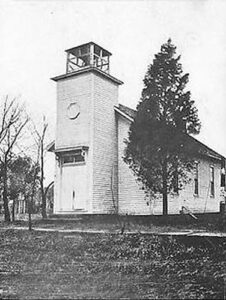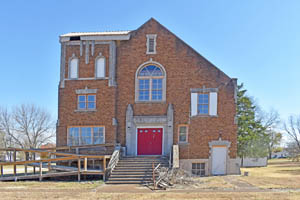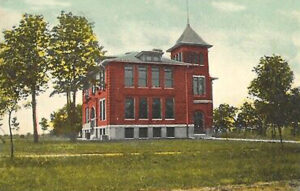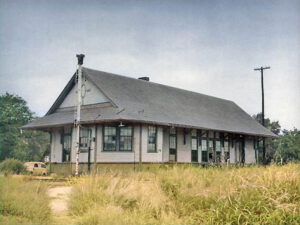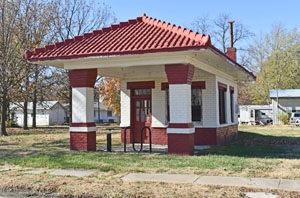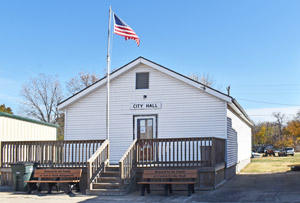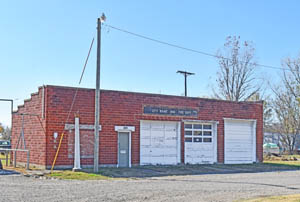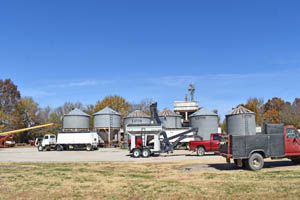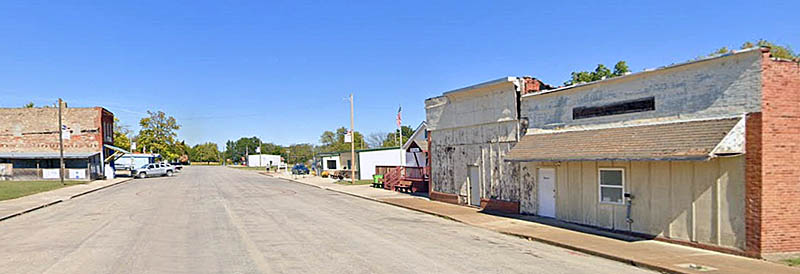
Main Street in Walnut, Kansas, courtesy Google Maps.
Walnut, Kansas, is a small town in the northwestern part of Crawford County. As of the 2020 census, its population was 187, and its total area was 1.00 square mile, of which 0.99 square miles was land and 0.01 square miles was water.
This community was initially named Glenwood upon its establishment.
The Methodist congregation was organized in 1869 in F. Robins’s residence. At that time, it had ten members. Services were held in Robins’ residence during inclement weather and in the groves when weather permitted. The Catholic Church was first organized in Neosho County that year. One of the fathers from the Osage Mission organized it at John Mudd’s farm residence. In 1870, the meeting place was relocated to Walnut, where a small church building was erected.
The Presbyterians were organized into a church body by Reverend H.H. Camburn, who has since served as pastor. The organization took place in the schoolhouse, where the services were subsequently conducted for some time.
A small frame school building was erected in the fall of 1870, and J. Johnston taught the first school in the winter of 1870-1871.
The Missouri Pacific and Missouri, Kansas & Texas Railways were constructed through the area in 1871, providing the town with access to railroad lines.
The town was first laid out in 1871 by a town company, of which J. Miller, H. Burns, F. Robins, J. Burk, Dr. J.C. Petit, and Louis Giddings were members. The land was taken as a claim by H. Burns, who was furnished with money by the company, with which he could obtain a legal title. The original site comprised 40 acres, which were subdivided into town lots. This was part of the Osage lands, and the title was disputed between the Missouri, Kansas & Texas Railway and settlers. Among the early inhabitants of the town were Fabius Robins, J. Miller, Ira Boyle, H. Burns, H. Shackleton, and J.A. Goff.
H. Shackelton built the first house on the townsite. It was a little box house at the foot of Main Street, which he used as a storeroom for general merchandise. The next building was a grain elevator constructed by Jacobs & Burk, which was later occupied by Davis & Co. For a time, W. Jacobs used the building as a residence until the completion of his own dwelling, the third structure erected on the site. Jacobs, for a while, used his dwelling as a boarding house. Later, it was occupied by W. McFall, who maintained a hardware stock. S.H. Cover next erected a store and began dealing in general merchandise. Newton & Kelly followed with a merchandising establishment consisting of general goods.
When a post office was established on April 10, 1873, it was called Walnut Station, after Little Walnut Creek on which it is located. The town’s growth was extremely slow and unpromising during its first few years of existence.
In 1875, the townsite was purchased by Perry & Goff.
In 1876, the title to the ceded lands was quieted by the United States Court, which also addressed settlers’ concerns regarding property. In this way, the town was prepared for the more substantial and dynamic growth that followed.
On April 4, 1877, the town’s name was shortened to Walnut.
An addition to the school was built in 1879 to meet increased demand for educational facilities. That year, H.C. Bruner built Walnut Mills, a grist and flour mill.
In 1880, Steadman & Gregory established a large stock of general merchandise and operated a successful business. By this time, the town was growing; the townsite was resurveyed, and 40 acres were added. About a year later, J. Miller added 20 acres known as “Miller’s Addition,” and in the fall of 1882, the Robins & Goff and the Burns Additions were made, totaling 30 and 15 acres, respectively. The enlarged townsite then covered 145 acres.
The Methodists erected a church building in 1880 at a cost of $1,500. It is a tastefully constructed one-story frame structure, finished with a spire and equipped with a bell. By that time, church membership had increased to 60. In the same year, the one-story frame Presbyterian Church building was erected for approximately $1,000. The Baptist denomination also had a church organization that provided services in the schoolhouse.
By the early 1880s, Walnut was at the junction of the Missouri, Kansas, & Texas Railroad and the Nebraska, Topeka, Iola, and Girard Railroads.
E.O. Green began the Walnut Journal in December 1881.
In February 1882, Walnut Mills was sold to McCullough & Hollister, who installed a complete line of new and improved machinery. It contained three stone runs and had a capacity to grind 100 bushels of wheat and 300 bushels of corn per day. The principal market for the goods was Texas, and the orders received were much in advance of the supply. The mill building was a two-story frame structure measuring 24 by 36 feet, and a 40-horsepower engine supplied power.
The Walnut Herald was a five-column newspaper briefly published by J. Scurry in 1882. Its circulation was free, and the only revenue came from advertising.
A new school building was erected in the fall and winter of 1882. It is a two-story frame building measuring 30 by 50 feet and containing four rooms. The district’s bonds were approved to raise costs by approximately $3,000.
On November 1, 1882, E.O. Green sold a half-interest of the Walnut Journal to W.M. Holeman, who became associate editor and proprietor. The six-column newspaper was politically independent and had a circulation of 480 copies.
At that time, the business interests of the town were represented by three general stores, two hardware, two drug and three grocery stores, one restaurant, two hotels, a millinery and dress making establishment, two meat markets, a cabinet and furniture shop, two lumber and coal yards, three grain elevators, two livery stables, a hay press, two blacksmith and wagon shops, a harness shop, a carpenter shop, a barber shop, shoe shop, and two land offices. Situated at a considerable distance from all essential surrounding points, the town had the support of a large country trade.
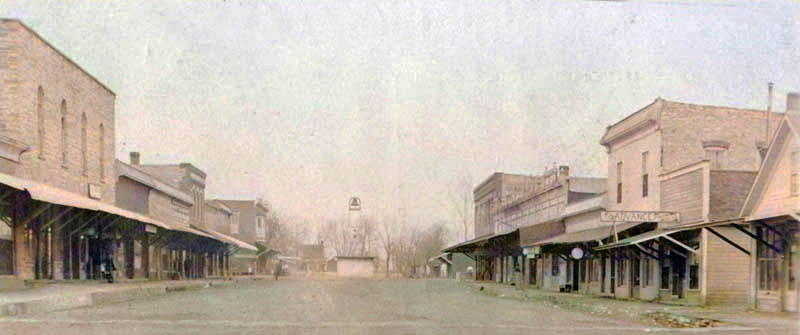
Walnut, Kansas, in 1908.
By 1910, Walnut was an incorporated city at the junction of the Atchison, Topeka & Santa Fe and Missouri, Kansas & Texas Railroads. At that time, it had a bank, an opera house, a flour mill, grain elevators two weekly newspapers — the Eagle and the Advance, two hotels, a washing-machine factory, which was also a sawmill and a manufactory for screen doors, a feed mill, a large number of retail establishments, telegraph and express offices and an international money order postoffice with five rural routes. The population in 1910 was 639.
Walnut’s population peaked at 650 in 1920. Afterward, the population declined.
Today, the area’s economy is primarily agricultural-based
The community’s students are served by USD 248, headquartered in Girard, Kansas.
Walnut is located 15 miles northwest of Girard, the county seat, eight miles from St. Paul, and about 27 miles from Fort Scott.
©Kathy Alexander/Legends of Kansas, updated December 2025.
Also See:
Extinct Towns of Crawford County
Sources:
Blackmar, Frank W.; Kansas: A Cyclopedia of State History, Vol I; Standard Publishing Company, Chicago, IL 1912.
Cutler, William G.; History of Kansas; A. T. Andreas, Chicago, IL, 1883.
Home Authors: A Twentieth Century History and Biographical Record of Crawford County, KS, Lewis Publishing Company, Chicago, IL, 1905.
Wikipedia

